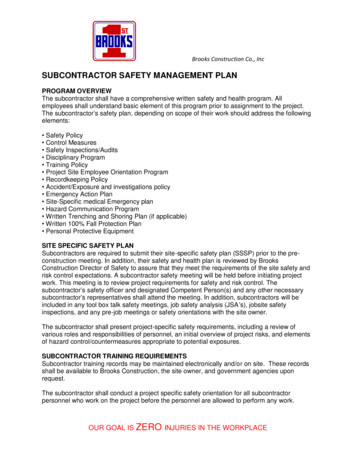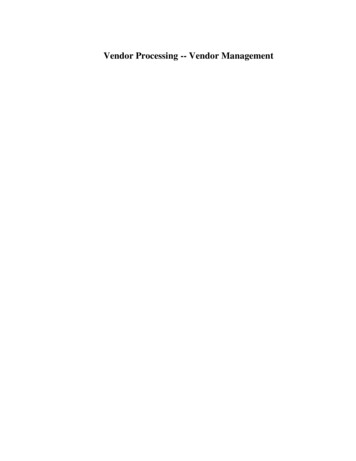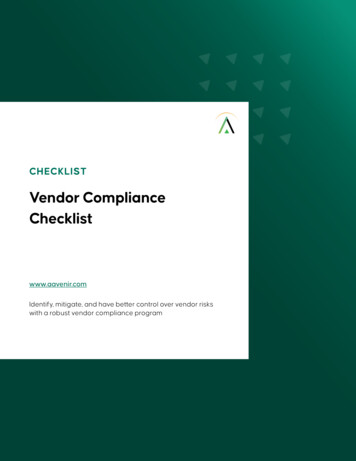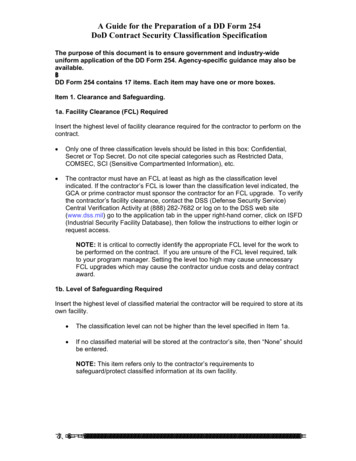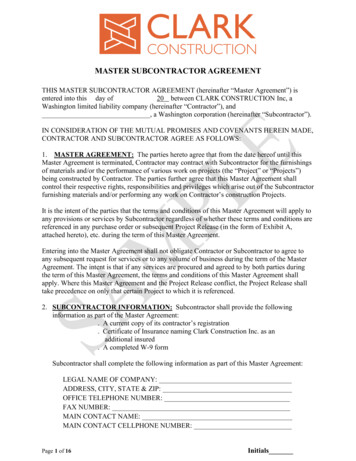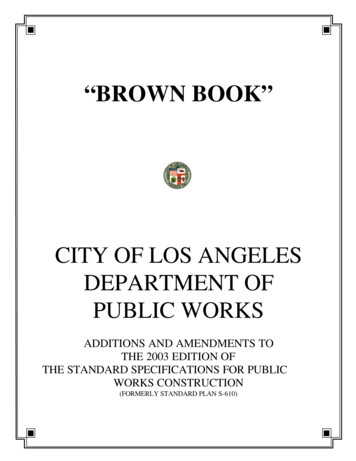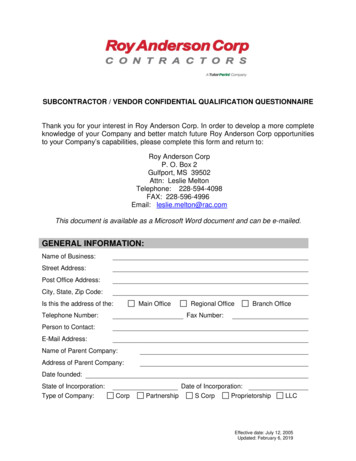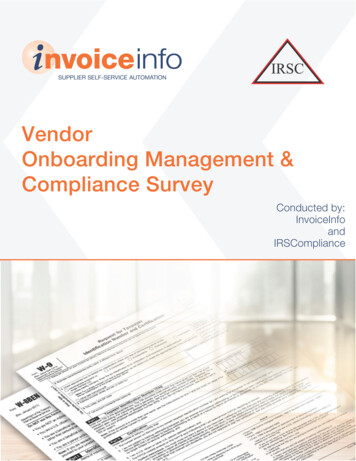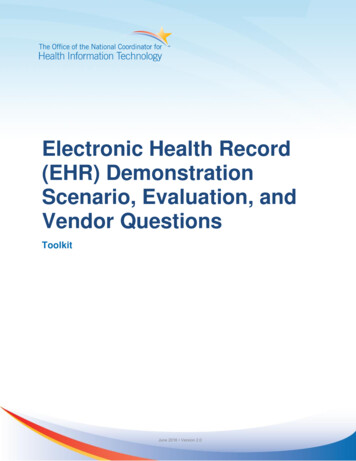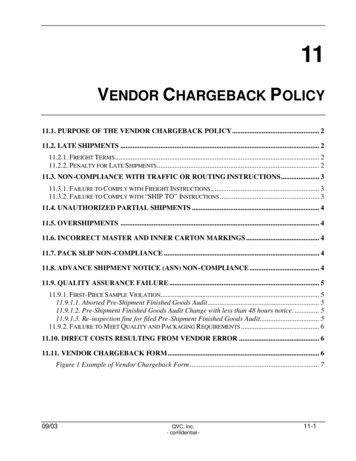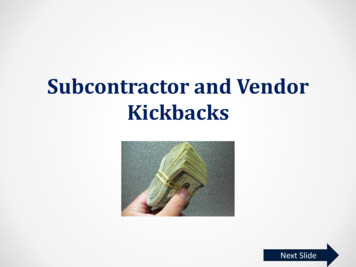
Transcription
Subcontractor and VendorKickbacksNext Slide
Table of ContentsRisk Assessment – Research and PlanningPreliminary Analytical ProceduresEntrance ConferenceAudit Team Brainstorming for Fraud Risk AssessmentResults from Audit ProceduresExpanded Audit Procedures and ResultsAdditional Follow-up ActionsFurther ActionsGeneral Comments and Lessons LearnedFraud IndicatorsPrevious Slide2Next Slide
Risk AssessmentResearch and PlanningThe auditor was assigned an incurred cost audit at XYZ, a non-major contractorwith a mix of commercial and Government fixed-price and cost-type primecontracts and subcontracts. The contractor submitted the incurred costsubmission for the previous year’s costs several months prior, and an auditordetermined that the submission was adequate for audit. The auditor reviewedgeneral risk assessment information about the contractor, including thepermanent file, previous incurred cost audits, the internal control questionnaire(ICQ), and the post-award accounting system audit. The auditor documentedthat prior auditors only questioned minimal costs in previous incurred costsaudits and that the accounting system was considered adequate for the incurredcost year under review.Because the internal control questionnaire in the permanent file was not current,the auditor submitted a written request to the contractor’s representative toobtain an updated internal control questionnaire for the year under audit. Theauditor also took the opportunity to schedule an entrance conference.Previous Slide3Next Slide
Preliminary AnalyticalProceduresThe auditor performed the analytical mandatory annual audit requirement(MAARs) procedures in the standard audit program, including indirect costcomparisons with the prior year’s actual costs and the budget for the yearunder review. The auditor identified sizable increases from both the budgetand prior year historical costs in several unallowable overhead accounts. Theauditor also noted that voluntary deletions in the submission were muchlarger than in the previous years’ submissions and the costs charged to thebusiness meals overhead account increased significantly.Previous Slide4Next Slide
Entrance ConferenceThe auditor obtained a walk-through of the incurred cost submission from thecontractor’s representative to gain an understanding of the basis for thesubmission and the available supporting documentation. The auditor alsoasked the contractor the following series of questions regarding thesubmission and the updated internal control questionnaire provided by thecontractor’s representative to identify potential fraud risks.Previous Slide5Next Slide
Entrance Conference(Continued)Auditor Question: “Why did charges to the unallowableoverhead accounts increase nearly 150 percent from theprior year’s actual costs?”Contractor Response: “I guess we just incurred more ofthese costs this past year. However, I’m not sure why youare concerned about our unallowable accounts since theywere all voluntarily deleted from the claimed costs.”Auditor Question: “What changes have been made in theprocess for screening for unallowable costs?”Contractor Response: “None that I am aware of. Ourpolicy is still to review our costs for allowability whenincurred. Same people doing the same thing.”Previous Slide6Next Slide
Entrance Conference(Continued)Auditor Question: “Why did the costs charged to theoverhead account for business meals increase 60 percentfrom the prior year’s actual costs and 75 percent from thebudget for this incurred cost year?”Contractor Response: “I cannot specifically explain whythese account expenses were much higher than before.Perhaps we just needed to do more business-related travelor events in indirect support to our contracts. We had avery good year and increased our sales substantially so itseems reasonable to me that these types of expenseswould have increased as well.”Previous Slide7Next Slide
Entrance Conference(Continued)Auditor Question: “Speaking of sales, we noted that salesincreased about 75 percent over the prior year’s sales.The increase appears to be mostly Government-relatedsubcontract awards. However, the prime contractors forthese awards are not identified in the submission. Pleaseprovide us a listing identifying the prime contractors foreach newly awarded subcontract.”Contractor Response: “I would be happy to provide thatlisting but all subcontract awards were made by A PrimeContractor. We have established a very active businessrelationship with A based on mutual synergies andcomplementary services and products.”Previous Slide8Next Slide
Entrance Conference(Continued)Auditor Follow-up Question: “How were these awardsmade?”Contractor Response: “I will confirm, but I am pretty surethese were sole-source awards based on our newly formedteaming arrangement with A Prime Contractor.”Previous Slide9Next Slide
Entrance Conference(Continued)Auditor Question: “What areas of XYZ’s business hasmanagement identified as being high risk for potentialfraud?”Contractor Response: “We are a small company. Allemployees are like family. We do not believe that anyemployee is capable of or would commit any type of fraudagainst the company.”Auditor Follow-up: “Please describe XYZ’s businessethics program and related policies and procedures.”Contractor Response: “We have business ethics policiesand we provide annual ethics training to all our employees.Also our employees all know they can contact our legalcounsel if they have any ethical questions or concerns.”Previous Slide10Next Slide
Audit Team Brainstorming forFraud Risk AssessmentThe auditor and supervisor discussed the results of the riskassessment/preliminary audit procedures and brainstormed about thevarious risks of fraud related to the audit. The only indicator identified anddiscussed was the increase in sole-source subcontracts from the same primecontractor.Previous Slide11Next Slide
Audit Team Brainstorming forFraud Risk Assessment(Continued)The audit team concluded that the procedures in the standard audit programwere generally sufficient to address the risk of unallowable costs in thesubmission. However, to address the risk of fraud, the audit team decided toinclude the following audit steps in the audit plan: Review the transactions comprising the voluntarily deleted (for example, unallowableentertainment, travel, employee morale, business conferences, etc.) costs in thesubmission to ascertain the types of costs incurred and not claimed forreimbursement.Review the business meals overhead account by performing a statistical sample of theaccount transactions with a sufficient sample size to address a high risk of significantmisstatements in the account (high expected error rate), which the auditor is unwillingto accept (low tolerable misstatement). Trace the items selected for review back tosource documents to determine the allowability, allocability, and reasonableness ofthe costs.Previous Slide12Next Slide
Results from Audit ProceduresThe auditor performed the planned transaction testing and identified thefollowing issues during that testing: Most of the voluntarily deleted transactions were charged to theunallowable travel, unallowable conferences, and unallowable businessmeals accounts. These transactions included non business-related itemssuch as resort vacation packages, tickets to various sporting events,concert tickets, and carpeting for personal residences. More than 50 percent of the transactions reviewed in the business mealsoverhead account were not properly documented. The supportingdocumentation had the names of the individuals who were present, butthe reason for the meeting/meal was not recorded, as required.Previous Slide13Next Slide
Expanded Audit Proceduresand ResultsThe auditor and supervisor discussed the results of the testing and decided toexpand testing of the business meals account. In addition, they discussedthat the contractor could have charged other questionable paymenttransactions in related accounts such as travel and conferences.They decided to perform the following additional procedures. The auditor selected and reviewed additional transactions under anexpanded statistical sample for the business meals overhead account andfound several more transactions lacking documentation of the businesspurpose. However, as in the initial testing, the names of the participantswere listed, and the auditor noticed that the individuals listed were thesame as those found in the initial testing. Overall, approximately 50percent of the charges reviewed from both the initial and expandedtesting were not properly documented.Previous Slide14Next Slide
Expanded Audit Proceduresand Results (Continued) The auditor developed a worksheet of thebusiness meal account transaction detail(employee, dates, venues, locations, participants, etc.)to review for any patterns. This enabled the auditor to determine that thesame company employees paid for the same individuals’ lunches anddinners on a routine basis. To address the risk of more questionable transactions in other relatedaccounts, the auditor reviewed the travel account and conference accountdetails and noted that several airline and hotel expense transactionscorresponded to the same locations as those of the questionable businessmeals/meetings. Many expenses were to or in resort locations. Theauditor’s review of the travel vouchers noted a pattern that the employeeswho submitted these travel vouchers were the same employees whosubmitted the expense vouchers for the questionable businessmeals/meetings.Previous Slide15Next Slide
Expanded Audit Proceduresand Results (Continued) The auditor compared the listing of individuals associated with thequestionable business meals/meetings to those individuals associatedwith the voluntarily deleted non business-related purchases identified inthe review and noted that the lists contained many of the same names. Recognizing that the transactions identified in the various accounts werean indicator of inappropriate kickbacks or bribery payments, the auditorcompared the subcontract award dates from A Prime Contractor with thedates of the questionable transactions. This comparison revealed apattern that purchase dates were typically within a month after award of asubcontract.Previous Slide16Next Slide
Additional Follow-up ActionsDuring discussions between the auditor and the contractor’s representativeon the identified deficiencies in the documentation, the contractor’srepresentative stated that the individuals involved worked for A PrimeContractor and the expenses were likely various business meetings to discussthe new subcontract effort.The auditor also discussed with the contractor’s representative that there didnot appear to be any directly related costs (such as labor, travel, etc.)associated with the voluntarily deleted payment costs. The auditor requestedthe contractor’s representative provide a written response either identifyingany directly related costs that were not deleted from the submission orstating that there were none.Previous Slide17Next Slide
Additional Follow-up Actions(Continued)The auditor contacted the audit office responsible for auditing A PrimeContractor to discuss the results of the audit and the pattern of irregulartransactions between XYZ and A Prime Contractor. The supervisory auditorresponsible for auditing A Prime Contractor said that they had recentlyissued a purchasing system deficiency report on this contractor’s system. Thecited deficiencies included failure to (1) maintain justification documentationfor sole-source awards and (2) perform adequate cost/price analysis for itssubcontracts. The supervisor also offered to look through the permanentfiles and use the online system access to try to identify where the A PrimeContractor individuals involved with the questionable transactions workedwithin the company. Several days after this discussion, the supervisor emailed the auditor that the individuals in question were mostly subcontractadministrators in the procurement department with the remainder beingprogram management personnel. The supervisor also attached a copy of thepurchasing system deficiency report.Previous Slide18Next Slide
Further ActionsThe auditor and supervisor concluded that a written fraud referral, Defense ContractAudit Agency (DCAA) Form 2000, should be submitted immediately beforecompleting the incurred cost audit. The auditor decided to have an informaldiscussion regarding the audit findings and referral with the DCAA investigativesupport auditor. The investigative support auditor suggested that certaininformation and documentation be included in the fraud referral. Additionally, giventhe potentially illegal nature of the payment transactions, the investigative supportauditor stated that contractor management may know about the activities and mighthave already submitted a contractor disclosure to the DoD Office of InspectorGeneral (The DoD Contractor Disclosure Program). The investigative support auditoradvised the auditor to check the permanent files to see whether their office had areceived a contractor disclosure for this matter but also offered to check a listing ofdisclosures for both XYZ contractor and A Prime Contractor. Shortly thereafter, theinvestigative support auditor sent a follow-up e-mail confirming that neithercontractor had submitted a disclosure.For an example of a Form 2000, see www.dodig.mil/resources/fraud/pdfs/DCAAF2000 5505.pdf.Previous Slide19Next Slide
Further Actions (Continued)The auditor then set up a teleconference for their audit office, the audit officecognizant of the A Prime Contractor, the local DoD criminal investigator, theinvestigative support auditor, and the DCAA Justice Liaison Auditor to discussthe pattern of irregularities identified in the audit and the forthcoming fraudreferral.The auditor and supervisor also had a meeting with the AdministrativeContracting Officer (ACO) and the Defense Contract Management Agency(DCMA) procurement fraud attorney to discuss the audit findings to date andthe impact on the reliability of the contractor’s business systems. Thesupervisor explained that a follow-up review of the contractor’s businessethics program for compliance with the Federal Acquisition Regulation (FAR)and Defense Federal Acquisition Regulation Supplement (DFARS)requirements would be initiated as soon as possible.Previous Slide20Next Slide
General Comments andLessons LearnedThe Anti-Kickback Act defines kickbacks as any money, fee, commission,credit, gift, gratuity, thing of value, or compensation of any kind that isprovided directly or indirectly, to any prime contractor, prime contractoremployee, subcontractor, or subcontractor employee for the purpose ofimproperly obtaining or rewarding favorable treatment in connection with aprime contract or in connection with a subcontract relating to a primecontract. However, detection of vendor kickbacks in the course of routinecontract auditing is difficult. Standard audit procedures normally will notuncover such schemes.Previous Slide21Next Slide
General Comments andLessons Learned (Continued)The auditor must be alert to obvious weaknesses in the contractor's internalcontrols that make taking payoffs or accepting inappropriate gifts easy. Whenthese indicators are identified, the auditor should be proactive and considerthe following: contacting DCMA and recommending they initiate audits of the primecontractor’s material purchasing, receiving, and storing systems to identifyother weaknesses or noncompliance with existing contractor policies andprocedures, performing physical verification of the existence of inventories ormaterials charged directly to a job to identify how vulnerable thecontractor’s system is to fraud, and performing a subcontract management review to evaluate the primecontractor’s policies and procedures for awarding orders to vendors toensure that proper procedures are followed.Previous Slide22Next Slide
General Comments andLessons Learned (Continued)Auditors should still refer potential inappropriate payments even when theyhave been recorded as unallowable or voluntarily deleted from thesubmission. The very act of making the payments constitutes a potentialcriminal violation of the Anti-Kickback Act whether the questionablepayments are actually charged to Government contracts.Previous Slide23Next Slide
Fraud Indicators None or few contractor policies on ethical business practicesincluding lack of anti-kickback training required for bothemployees and subcontractor employees. Poor enforcement of existing contractor policies on conflicts ofinterest or acceptance of gratuities. Poor contractor internal controls over key functional areas, suchas purchasing, receiving, and storing. Lack of separation of duties between purchasing and receiving. Lack of separation of duties in the purchasing department. Buyersshould be rotated to prevent familiarity with specific vendors.Previous Slide24Next Slide
Fraud Indicators (Continued) Indications of poor or no established contractor procedures forcompetition of subcontracts such as:– lack of competitive awards;– poor documentation supporting award of subcontracts, particularly solesource awards;– lack of or inadequate cost/price analysis for subcontract awards; and– non award of subcontract to lowest bidder. Instances of buyers or other employees circumventing establishedcontractor procedures for competition of subcontracts. Purchasing employees maintaining a standard of living obviouslyexceeding their income. A one-time payment for services or materials usually bought fromanother vender(s). The kickback recipient could be using thecompany to obtain his payoff.Previous Slide25Next Slide
Fraud Indicators (Continued) Supporting documents for transactions that indicate potentialpayments of commissions, entertainment, travel, expensive gifts orun-repaid loans to prime contractor personnel or governmentofficials. Indications of patterns or relationship between potential irregularpayment transactions and contracting/subcontracting actions suchas awards, change orders, modifications, or other favorablecontracting actions. Equipment charged to contract that cannot be located. Services charged to contract that cannot be substantiated asperformed.Previous Slide26
permanent file, previous incurred cost audits, the internal control questionnaire (ICQ), and the post-award accounting system audit. The auditor documented that prior auditors only questioned minimal costs in previous incurred costs audits and that the accounting system was considered adequate for the incurred cost year under review.

